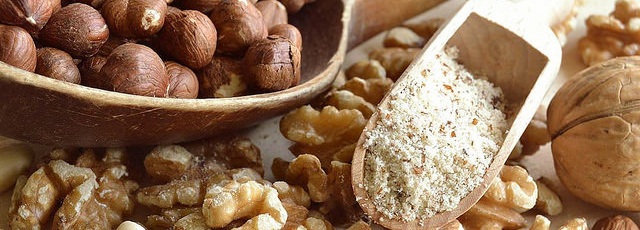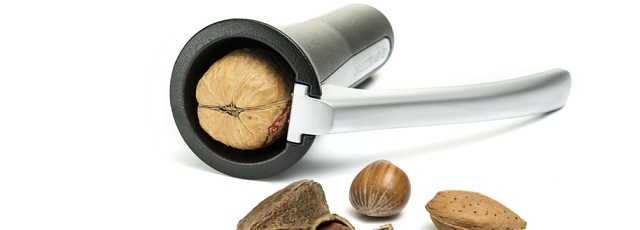There is no doubt – nuts have been serving men for thousands of years. They are not only very convenient for transfer, but they also allow to be stored during the long harsh winter spell. Nuts and candies, spiced cakes and sweetmeats, were some of the delicacies St. Nicholas fetched to children at Christmas time. According to Medieval physicians nuts were ruled by Jupiter and called jovial, and they were classified as warm and dry, and doctors recommended them fresh as a laxative.
Almonds
These regal nuts were mentioned in the history of the olden times as a precious ingredient in the bread of Egyptian Pharaohs. One of the first mentions of almonds in ancient times was made in the Bible – some biblical characters from the time of Joseph traded with almonds. The wand of Aaron makes the almond trees bear fruit magically; by this wonder proving that he is the Lord’s chosen.

The Drosselmeyer Nutcracker. Visit our Shop
Ancient people of the Middle East used almonds in their diet: they were served blanched, fried, crushed and whole. Almond oil was used by adepts of natural medicine in a lot of European and Middle Eastern cultures since Anno Domini.
An ancient Roman tradition is to throw almonds at the newly-wed as a wish for fertility. Today we throw rice, but at weddings sometimes guests are still served little bites with a few candied almonds.
In Switzerland people have a wonderful tradition – every year on Christmas day the households bake rice pudding, in which they hide an almond – it brings luck in the entire year for the family member who eats it.
Walnuts
Recent archaeological excavations in Israel have discovered remains of kinds of walnuts, which according to scientists date back to 780,000 years ago. In the Greek mythology, the God Dionysus had a secret flame named Carya, a virgin woman he could not conjugate with, and the afflicted lover decided to shapeshift her into a walnut tree. She has been celebrated in Classical antiquity as a Goddess of the Nut tree.
The oil of walnuts was widely used in the Middle Ages even as an alternative to olive oil, and peasants used to chop walnut shells for the preparation of bread. Walnuts candied in honey and sugar were considered among the choicest confections.
Together with figs, walnuts were considered a popular food for Lent.
Pistachio
According to ancient manuscripts, pistachio trees were grown by king Nebuchadnezzar in the Hanging Gardens of Babylon – one of the seven wonders of the Ancient world. Legend has it that they were one of the favorite treats of the Queen of Sheba. The Romans imported pistachios to Europe from Asia around the first century AD. Emperor Vitellius presented this delicious nut in his capital city. Together with the almonds, they are one of the two nuts mentioned in Scripture. According to a legend, the pistachio was one of the foods, which Adam brought to Earth.
Since Biblical times the ground pistachio has been added to puddings, conserved fruit or creams and different sauces for main courses all around the globe.
There is a wonderful superstition from the Middle East and China: the lovers, who meet under the pistachio tree on a moonlit night and hear the nut snapping open in its legendary smile – will be luckily in love.
Hazelnut
The homeland of the hazelnut tree is Minor Asia. People started gathering hazelnuts in the Neolithic. In the Antiquity, people believed that they prevent thunderbolts, incantation, and help avoid mean powers, snakes, mice etc.
The history of the hazelnuts dates from those most ancient times, mentioned by historians. They were most often present in the diet of the Romans. At that time, people believed they come from Damask and Syria, where they grew in the wild. Archaeological excavations in China reveal stoned hazelnuts from 5000 years ago. One of the most interesting discoveries has been recently made around Scotland, where they found proof that hazelnuts have been processed more than 9000 years ago. In the ancient medicine, hazelnuts are used for stirring of healing concoctions for different maladies.
Peanut
Peanuts have been consumed by people since ancient times, but what happened to them recently made them global. Archaeologists have found proof that peanuts originate from what’s today Paraguay and then the culture spread to Peru and to Northern South America. Europeans run into it in the Age of Explorations and introduced the peanut to Africa. The traders of slaves brought the peanuts in the USA in the 18th century, raising them especially for cattle food or as a replacement of cocoa, or for the butter. John Harvey Kellogg invented the peanut butter since he happened to be a vegetarian, looking for an alternative to cow’s butter. Right after he discovered it the American Vegetarian Society started producing the peanut butter in fabulous quantities. Within five years it became successful in the entire USA. The business expands dramatically in the 1920s and becomes a major food item for children in the 1930s.
Nowadays Americans wonder, does life even exist without peanut butter? 85% of the families in America have at least one jar of peanut butter in their fridge. It is crunchy or smooth, and it can be added to absolutely anything.
Chestnut
For centuries chestnuts have been a basic part of the diet of Europe and the Middle East. People used them in medicine: it was believed that they protect against rabies and dysentery. But its main function has always been food, especially for cold areas. The Sweet, also called “European” chestnut is native to Western Asia. Cooks used to grind the starchy nut to flour and mixed it with wheat flour from which they made bread in medieval Europe especially in times of famine. The chestnuts were considered nutritious, but hard to digest, causing wind or constipation.
Image Copyright: Met Museum, License: CC0 1.0



